-
25 November 2017
https://www.sacurrent.com/sanantonio/gentle-giant/Content?oid=2268857
At 79, he has outlived his most outspoken critics and several spans of public scorn. Most of those who know his name today are activists or labor liberals — and they have only praise for him, despite his long and entirely public or “open” membership in the Communist Party, USA.
“He’s a true organizer, of a dying breed,” says Graciela Sanchez, director of the Esperanza Peace & Justice Center.
Those who have dealt with Stanford over the years say that rather than pose as a militant, he speaks in the voice of consensus and prudence.
But Stanford wasn’t always viewed as the mild character that he seems to be today. There was a time when he was seen as a threat to the free world.
In 1950, he entered the peace movement by circulating the Stockholm Peace Petition, which called for banning nuclear weapons, and was roundly viewed as a conspirator in a global plot to further Stalin’s aims.
Stanford says that the joined the Party on the day after his discharge from the U.S. Navy in 1946. He became an activist within weeks, soon after re-enrolling at the University of Texas at Austin. Late that year, the Houston Informer reported that Stanford gave a speech in the basement of a Baptist church, under the sponsorship of the youth wing of the NAACP.
“White students are learning that it is time for them to fight for the rights of the Negro people,” he declared, characteristically throwing in a bit of wishful thinking. “If we increase our unity, we can make of the South a place where everyone can have a decent living, health, and education facilities.”
Stanford, who is white, delivered his Houston speech to support a lawsuit by Heman Sweatt, a black postal worker, to gain admission to the University of Texas law school. It was not the kind of speech that ordinary white men gave in that era of poll taxes and statutory segregation.
“In the South in the 1930s and 1940s, there were very, very few whites who spoke out for racial equality,” explains Maurice Isserman, the nation’s leading scholar on American communist affairs. “To do so was to put your life at risk.
And in many instances, the white Southerners who were willing to take that risk were in, or close to, the Communist Party.”
Sweatt’s legal challenge, won in 1950, is today seen as a precedent to the more-famous 1954 ruling in Brown vs. Board of Education, which ordered the integration of all public schools.
Because of his victory, Sweatt posthumously became a Texas hero, his portrait displayed at the Institute of Texan Cultures, a scholarship and college campus named in his honor.
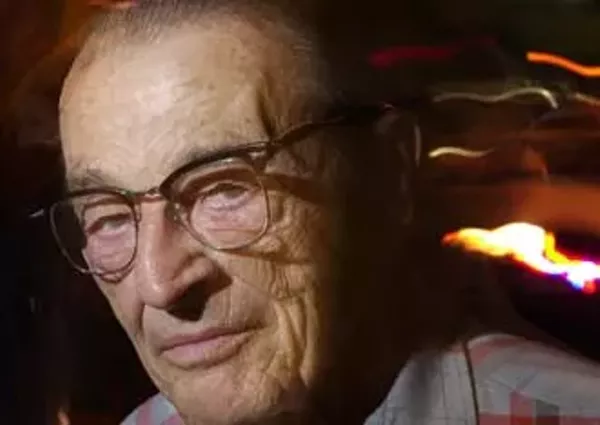 |
| John Stanford was one of the few whites who spoke out for racial equality in the 1930s and 1940s. Photos by Mark Greenberg |
The Meerschaum pipe Members of the Communist Party customarily don’t reveal the names of members or former members who are still alive. But Sweatt’s death has freed Stanford to declare that at the time of the suit, Sweatt, too, was a Communist Party member. Unlike Sweatt, Stanford was never closeted, even if it was because he had little choice, thanks to the Texas Legislature and the Houston police. He moved to the Bayou City following his graduation from UT, and on September 16, 1948 — El Diez y Seis de Septiembre, Mexican Independence Day — the bilingual agitator was arrested for distributing Party leaflets decrying “the ruthless economic, political, and social oppression of the Mexican-American people.”
In 1951, Texas passed a Communist Control Act that required Party members to register with authorities, and prescribed a two- to 10-year prison term for failure to comply with the law. The Party decided to challenge the law’s dubious constitutionality, and Stanford, who was by then living in San Antonio, volunteered to be the test case, mailing an open letter to officials in 1952, declaring his membership. According to the plan, he was to refuse to register when the authorities responded.
But the 1950s were tough times for even the Party’s bravest members. Eleven national leaders of the group had been indicted under federal anti-communist laws, and some of them were already behind bars. After Stanford mailed his statement, the Party’s leadership found that it didn’t have the resources to pursue the Texas challenge, and ordered him to go underground.
“The Party had made a big mistake,” Stanford observes today. “It thought that fascism was coming.” He doesn’t remember everything that happened afterwards, partly because aging takes a toll, and partly, he says, because he tried to forget.
“I used to keep photo albums,” he recalls, “but when I went underground, I cut the faces out of the pictures, so that the FBI wouldn’t harass my friends. But the thing is, then I forgot, too, and can’t match names with faces now.”
To avoid arrest, he fled to Alabama, and knowing no one, found a job as a waiter at a diner and tried to lay low. But he couldn’t; it wasn’t in him to sit on the sidelines. After a few weeks in Birmingham, Stanford began attending meetings of a committee that was opposing fare hikes on city buses. Alabama bus fare activists, however, were wary of the Texan who showed up as if from nowhere; they thought that he was an FBI agent.
Stanford’s arrangement with the Party — like a scene from a movie about the French Resistance — was that he was to stay out of view for six months, then place a classified ad in the leading daily newspaper, saying that he had lost a meerschaum pipe. The person who called to report the discovery of the meerschaum, the plan went, would become his contact with the Party.
Stanford placed the ad and a young woman called. He asked her to meet him at the diner on a Sunday morning, when business was slow. Joanna Tylee walked in, she recalls, and upon seeing the Texan whom she remembered from the bus fare meetings, thought that she had walked into a trap.
The pipe plot had a happy ending: Joanna Tylee is today Jo Stanford. Following their marriage, John returned to San Antonio, and with her, reorganized the city’s frightened Communists and raised two children in the Jefferson neighborhood.
A Rosewood raid Back in Texas, prosecutors hadn’t forgotten Stanford. Through informers, they and the FBI kept eyes on the quiet-spoken protester, and as late as September 1963, San Antonio Express and News headlines assured its readers that “D.A. Still Studying Stanford.”
Officials had plenty of authority under which to act against him: Augmented by new measures, Texas laws by then prescribed 30-year prison terms for unregistered Reds. But the feds asked that Texas officials wait to nab Stanford until he could be designated as a Communist by the federal Subversive Activities Control Board, which delivered its finding on December 26, 1963.
Hours later, search warrant in hand, seven men from the district and state attorneys offices knocked on the door of the Stanford home, which was then on Rosewood Street, in the Beacon Hill area. John Stanford wasn’t home; Jo admitted the raiders and promptly telephoned the press. Meanwhile, her visitors began boxing some 2,000 books and various papers, including the couple’s marriage license, insurance policies, and mortgage schedule. The raid lasted for five hours. When reporters arrived, according to the Express and News, Jo welcomed them with, “Come on in and join the party!” But then she caught herself. “Or should I use another word?” she joked. The searchers claimed that the raid was necessary to prove that Stanford was imperiling public safety by selling Communist books and tracts through a mail-order bookstore in his home called All Points of View, which he had been operating since 1961.
In the months that followed, Stanford and his attorney, the late Maury Maverick Jr., were frequent subjects of the local press, whose handling of the affair betrayed an acquired admiration for the suspect. Reporters described Stanford as “affable,” and “pipe-smoking,” a designation that, in days before bongs, connoted “reflective” and “calm.”
Litigation over the book seizure wound up before the U.S. Supreme Court, where Maverick pointed out that among the confiscated items were copies of legal opinions on anti-communist laws penned by Justice Hugo Black.
“The reference to Justice Black’s opinion brought chuckles from the bench and several humorous exchanges that brightened the hushed dignity of the marble courtroom,” Express writer Ned Curran reported from Washington when the Court heard the case.
To almost no one’s surprise, the Court ruled the raid on Rosewood invalid, and the DA’s men, driving a borrowed red-and-white pickup, returned Stanford’s books to Rosewood.
They probably didn’t intend to aid or encourage the unarmed Stanford to overthrow the government, but the lawmen also gave him a gun, a .38-caliber pistol that had been taken for evidence in an unrelated case. Stanford, who has always claimed that he is for “socialism by peaceful and democratic means,” promptly returned the weapon.
Lingering suspicions Stanford’s victory before the Supreme Court kept him under public glare even after the ruling was old news. In 1965, an Express reporter grilled Stanford, who attended a demonstration to protest the killing of Reverend James Reeb during the Selma-to-Montgomery march led by Martin Luther King Jr.
Perhaps hoping to tarnish the voting rights movement, the reporter asked Stanford to justify his presence at the event. “I participated for the reason tens of thousands participated across the country — as a protest against the brutality being practiced against the Alabama Negroes,” Stanford shot back.
Six months later, his activities were again assailed in the local press when he sent anti-war leaflets to a mailing list that he had compiled, drawing a complaint from a soldier’s mother — not in San Antonio, but in distant El Paso.
“I believe the wars in Vietnam and the Dominican Republic endanger the lives of all American servicemen — including this woman’s son,” he told an inquisitor from the Express.
In the years since Vietnam, Stanford has taken part in dozens of other causes: the unionization of Valley farm workers, the campaign to Free Angela Davis, protests over U.S. involvement in Central America, and since 2001, Thursday peace vigils at the San Fernando Cathedral.
At protests against the U.S. occupation of Iraq, he is saying much the same thing today that he has said since 1946. “Capitalism doesn’t have a future,” he maintains. He insists that Soviet interests were only a marginal concern of his. “We weren’t concerned about Stalin’s policies during the 1950s, we were fighting against the poll tax,” he says.
Young demonstrators may dismiss Stanford as too old, and his trademark causes too dated to be relevant now, but they don’t suspect him, as their forerunners did, of joining their protests with a hidden agenda in mind. The ironies of history are endless, and one of them is that it’s not because he has spent more than 50 years on the barricades, but because there is no longer a Soviet state, that nobody questions Stanford’s sincerity today.
http://www.bbc.co.uk/news/world-us-canada-42116688
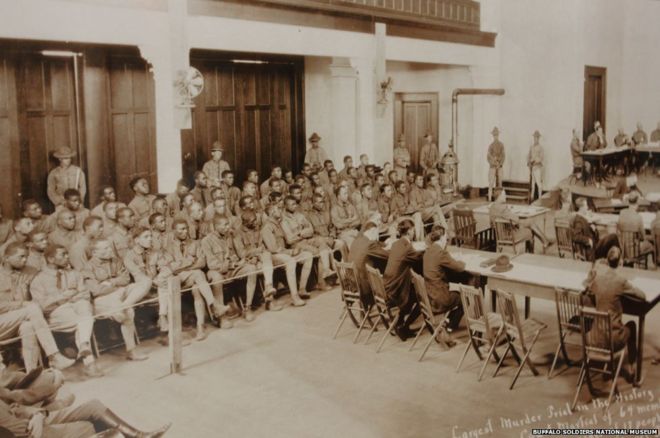 Image copyright Buffalo Soldiers National Museum
Image copyright Buffalo Soldiers National Museum It’s almost 100 years since 19 African-American soldiers were executed following a violent mutiny in Texas. Why is the US only now coming to terms with what happened?
For decades, no name appeared above the grave of Corporal Jesse Moore, only the number seven.
The figure corresponded to noose number seven which was used to hang him and another 12 African-American soldiers beside the Salado Creek of San Antonio in December 1917.
The executions followed the rainy August night when more than 100 armed soldiers marched into the city of Houston and during a two-hour riot killed 16 whites, including five policemen.
The resulting court martial staged in three parts was the largest in US military history.
A total of 118 enlisted black soldiers were indicted, with 110 found guilty, 19 hanged and 63 receiving life sentences.
“They were denied due process guaranteed by the Constitution and died horrible deaths,” says Angela Holder, Moore’s great-niece and a history professor at Houston Community College.
“They were represented by one lawyer and didn’t even have a chance to appeal.”
In the spring of 1917, Moore and his unit, the 3rd Battalion of the predominantly black 24th United States Infantry had been dispatched to Houston to guard the construction site of a new camp following the United States declaring war on Germany.
“They sent these soldiers into the most hostile environment imaginable,” says Charles Anderson, a relative of Sergeant William Nesbit, another of the hanged soldiers.
“There was Jim Crow law [which denied black people equal rights], racist cops, racist civilians, laws against them being treated fairly in the streetcars, while the workers building the camp hated [the soldiers’] presence.”
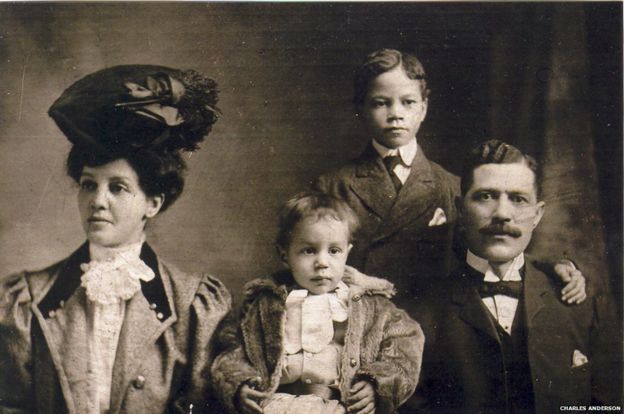 Image copyright Charles Anderson
Image copyright Charles Anderson Tensions continued to grow during the troops’ time guarding Camp Logan until the Houston police arrested a black soldier for interfering with the arrest of a black woman.
When one of the battalion’s military police went to inquire about the arrested soldier, an argument ensued, resulting in the military policeman fleeing the police station amid shots, before being arrested too.
Although he was later released, a rumour reached Camp Logan that he had been killed, coupled with talk of a white mob approaching the camp – there was none – resulting in soldiers grabbing rifles and heading into downtown Houston.
“It was dark and there was a big rain storm during the riot,” says Jason Holt, nephew of Private Thomas Hawkins who was hanged. “At the trial not one civilian could identify a soldier firing shots that killed people.”
Seven mutineers agreed to testify against the others in exchange for clemency.
Mr Holt has a 100-year-old letter written by Private Hawkins to his mother the night before his execution, telling her not to be upset about him taking his “seat in heaven”, and of his innocence.
Courtesy of Jason Holt
Dear Mother & Father,
When this letter reaches you I will be beyond the veil of sorrow I will be in heaven with the angels. Mother don’t worry over your son because it is heavens gain look not upon my body as one that must fill a watery grave but one that is asleep it in Jesus. [sic]
I fear not death. Did not Jesus ask death ‘Where art thy sting’ Don’t regret my seat in heaven by mourning over me. I now can imagine seeing my dear Grandmother and Grandfather and the dear girl Miss Bessie Henderson that I once love in this world standing at the river of Jordan beckoning to me to come and O! Mother should they be sensitive of my coming don’t you think that they are anxious for tomorrow morning to come when I will come unto them.
I am sentence to be hanged for the trouble that happen in Houston Texas altho I am not guilty of the crime that I am accused of but Mother it is God’s will that I go now and in this way and Mother I am going to look for you and the family if possible I will meet you at the river. Come unto me all ye that are heavy laden and I will give the rest, Bless his holy name. This is the happiest day I met with since Jesus spoke peace to my soul in Brookstone church from my promise to God I have strayed away but I am with him now.
Send Mr Harris a copy of this letter. I am your son, TC Hawkins, Fort Sam Houston, Tex
PS. Show this to Reverend Shaw – Reverend Shaw, I am with Jesus and I will look for you in that great morning
“The men did not have a fair trial,” says Sandra Hajtman, a lawyer and great-granddaughter of one of the policemen killed. “I have no doubt about the likelihood the men executed had nothing to do with the deaths.”
Soon after the executions, the US Army changed its uniform code of military justice to prevent executions without a meaningful appeal.
“The soldiers were 100% wrong for rioting, but I don’t blame them,” says Jules James, the great-nephew of Captain Bartlett James, one of the battalion’s white officers who managed to restrain a larger number of soldiers from leaving camp.
“The unit had 60 years of excellent service, was full of experienced veterans but couldn’t endure seven weeks of Houston.”
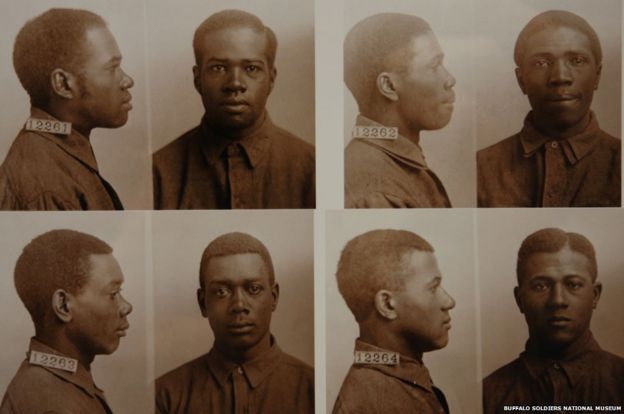 Image copyright Buffalo Soldiers National Museum
Image copyright Buffalo Soldiers National Museum A majority of the soldiers were raised in the South and familiar with segregation. But as army servicemen they expected fair treatment.
Houston police and public officials, however, viewed the presence of the black soldiers as a threat to racial harmony.
Many Houstonians were concerned that if the black soldiers were shown the same respects as white soldiers, black residents might come to expect similar treatment.
“This was a problem created by community policing in a hostile environment,” says Paul Matthews, founder of Houston’s Buffalo Soldiers National Museum, which examines the role of African-American soldiers during US military history.
“It’s up to people now to decide whether there are lessons relevant to the present.”
In Houston, knowledge about the riot varies – a rapidly growing city, most newcomers know nothing about an event that is rarely discussed.
“The business community, just as in other American cities with a story of racial trouble, preferred that it be forgotten – it’s not the sort of thing that builds tourism, after all,” says Mike Vance with the Heritage Society of Houston.
“But I most strongly disagree with any notion there was a decided attempt to not talk about it or any citywide memory lapse about it.”
 Image copyright Angela Holder
Image copyright Angela Holder The city leaders might not trumpet it, but it remains part of the collective memory of the population, Mr Vance explains.
“I think that is true of things as recent as the race riots of the 1960s in places like Detroit and Philadelphia and even the Rodney King riots in LA.”
Despite the tragedy, relatives of the soldiers recall growing up hearing their fates discussed by families, noting there was no shame attached.
“What happened at Camp Logan is a complex narrative to navigate,” says Lila Rakoczy, programme co-ordinator of military sites and oral history programmes at the Texas Historical Commission.
“There was no public acknowledgment of it for a long time, but now there is more willingness to talk about it.”
The centennial of US entry into World War One has probably brought a heightened awareness of such events and emboldened people to address a sensitive subject, Ms Rakoczy notes.
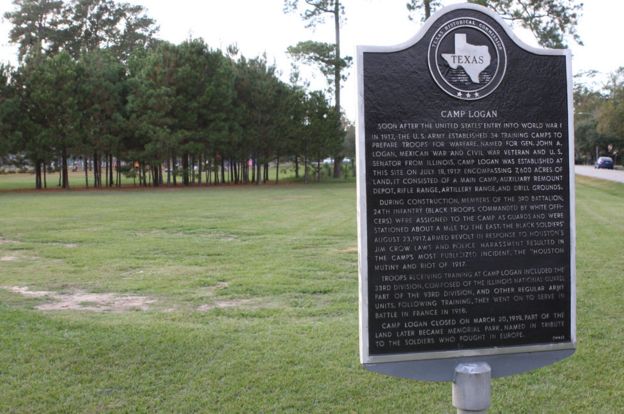 Image copyright James Jeffrey
Image copyright James Jeffrey This year Ms Holder helped lobby for gravestones from the Veterans Association for unmarked graves in a Houston cemetery of two soldiers killed during the riot. She says she also wants to obtain posthumous pardons for the hanged soldiers.
“We tried during the Obama presidency and were on the list but missed out,” she says. “Perhaps we can approach a Texas politician or the National Association for the Advancement of Colored People [NAACP] to help.”
Moore and those executed with him only received headstones after authorities became concerned that flood waters from the creek might unearth the bodies. So the executed soldiers were re-interred in San Antonio’s Fort Sam Houston cemetery in 1937, says Ms Holder.
Meanwhile, as the 100th anniversary of the day of execution approaches, other relatives are left wondering what might have been if their relatives had gone to Europe with the other 350,000-plus African-Americans who served in WW1.
“Instead of a noose around my ancestor’s neck they may have been hanging a medal,” Mr Anderson says.
“The military should never have sent a coloured unit to guard that camp.”